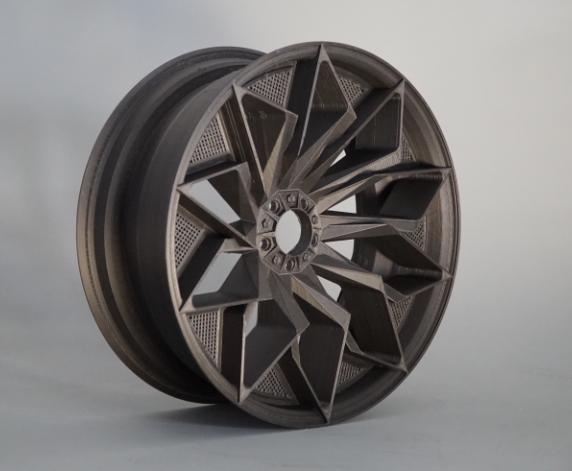President
- FMA
- The Fabricator
- FABTECH
- Canadian Metalworking
Our Publications
Categories
- Additive Manufacturing
- Aluminum Welding
- Arc Welding
- Assembly and Joining
- Automation and Robotics
- Bending and Forming
- Consumables
- Cutting and Weld Prep
- Electric Vehicles
- En Español
- Finishing
- Hydroforming
- Laser Cutting
- Laser Welding
- Machining
- Manufacturing Software
- Materials Handling
- Metals/Materials
- Oxyfuel Cutting
- Plasma Cutting
- Power Tools
- Punching and Other Holemaking
- Roll Forming
- Safety
- Sawing
- Shearing
- Shop Management
- Testing and Measuring
- Tube and Pipe Fabrication
- Tube and Pipe Production
- Waterjet Cutting
Industry Directory
Webcasts
Podcasts
FAB 40
Advertise
Subscribe
Account Login
Search
Metal and plastic 3D printing: hype and the quiet revolution
Compared to their metal counterparts, plastic 3D printers generate little buzz
- By Frank Marangell
- August 31, 2019
- Article
- Additive Manufacturing

BigRep America President Frank Marangell says despite the fact plastic 3D printing doesn’t receive the amount of media coverage metal does, it continues to transform mechanical designs, tooling, and dental and orthodontic processes.
Metal 3D printing has been the most talked-about technology in the additive manufacturing (AM) space the past few years. It offers the exciting, complex end-use capabilities that plastic 3D printing promised during its rise to media prominence 10 years ago.
Unlike plastic, though, metal delivered on its promise early on. During metal’s rise in popularity, it should be noted that thermoplastic AM has been undergoing a quiet revolution. It has methodically evolved, offering creative new applications for end-use parts and continual innovations for low-volume manufacturing.
The AM world has undeniably been changed by the growth of metal 3D printing. Every Fortune 500 company and start-up now wants a piece of the technology.
But in my view, two things have become clear: Metal AM is in the midst of a “hype cycle”—something that thermoplastic 3D printing is intimately familiar with—and given plastic’s consistent upward trend, it’s due to re-enter the limelight.
Parallel Development
Metal began to gain attention when GE Aerospace 3D-printed metal end-use parts for its LEAP engine fuel nozzle, legitimizing the technology for demanding engineering applications. The success became a catalyst for growth, causing other manufacturers to consider the technology and suppliers and research teams to pour funding into metal additive’s development. The hype surrounding the technology quickly grew as it was excitingly declared a true end-use additive solution.
The excitement surrounding metal 3D printing has overshadowed thermoplastic AM and the consistent innovations that have taken place during its 30-plus-year existence. Plastic 3D printing has continued to transform mechanical designs, manufacturing tooling, and dental and orthodontic processes, to name a few.
Innovations in thermoplastic end-use parts have developed in parallel with metal, but without the same fanfare. And industry has made an incorrect correlation between metal and plastic: Just because more new suppliers are entering the metal market does not mean that there is more innovation in metal than in thermoplastics.
The reality is that the plastic 3D printing market is much larger than the metal market.
Plastics are used more than metal in almost every manufacturing process, and so the potential to affect society is much greater with thermoplastic additive. You can’t get through your day without using hundreds of items that have been positively affected by plastic 3D printers in the design cycle.

Innovations in thermoplastic 3D printing include materials with strength comparable to common metals. Shown is a biopolymer rim for a 3D-printed motorcycle built on a BigRep machine.
New innovations in thermoplastic 3D printing are producing solutions that are well-qualified for end-use parts production. Additionally, new thermoplastic materials with strength comparable to common metals are increasingly available for fused filament fabrication (FFF) technologies. Viable engineering-grade materials like polyamide, ABS, carbon- and glass-filled materials, and others have increasingly entered the FFF market for use with additive systems like BigRep’s.
Many of these specialty plastics are being steadily adopted by industrial manufacturers for a variety of strength-dependent applications that were previously dominated by metal parts. And they often provide strength-to-weight ratios that far surpass aluminum.
AM Opportunities
It’s clear that the largest growth opportunities in AM still lay with thermoplastic—and not just because of the ongoing advancements in FFF technologies’ materials and applications. It’s also due to plastic’s many indirect benefits.
For example, as filament-shredding technology and biodegradable materials become increasingly attractive to industrial manufacturers working to create a sustainable, closed-loop manufacturing process that would see material costs drastically reduced, FFF technology becomes the only solution.
Metal 3D printing will find its “slope of enlightenment” [instances during a hype cycle when the advantages of a new technology start to be understood]. Concurrently, the additive revolution will continue to be led by a growing number of everyday manufacturing companies investing in and implementing thermoplastic AM processes that unlock additive’s benefits, such as driving down costs and improving quality, all while reducing stock levels and other logistics.
It’s exciting for the entire industry to watch as the use of additive processes grows. And as thermoplastic AM continues to establish its long-sought dominance in industrial and end-use applications, metal will reach the hype cycle’s “trough of disillusionment.” In the meantime, industry would do well to mind ongoing cutting-edge additive advancements in plastic!
About the Author

Frank Marangell
About the Publication
- Podcasting
- Podcast:
- The Fabricator Podcast
- Published:
- 04/16/2024
- Running Time:
- 63:29
In this episode of The Fabricator Podcast, Caleb Chamberlain, co-founder and CEO of OSH Cut, discusses his company’s...
- Trending Articles
- Industry Events
16th Annual Safety Conference
- April 30 - May 1, 2024
- Elgin,
Pipe and Tube Conference
- May 21 - 22, 2024
- Omaha, NE
World-Class Roll Forming Workshop
- June 5 - 6, 2024
- Louisville, KY
Advanced Laser Application Workshop
- June 25 - 27, 2024
- Novi, MI


























